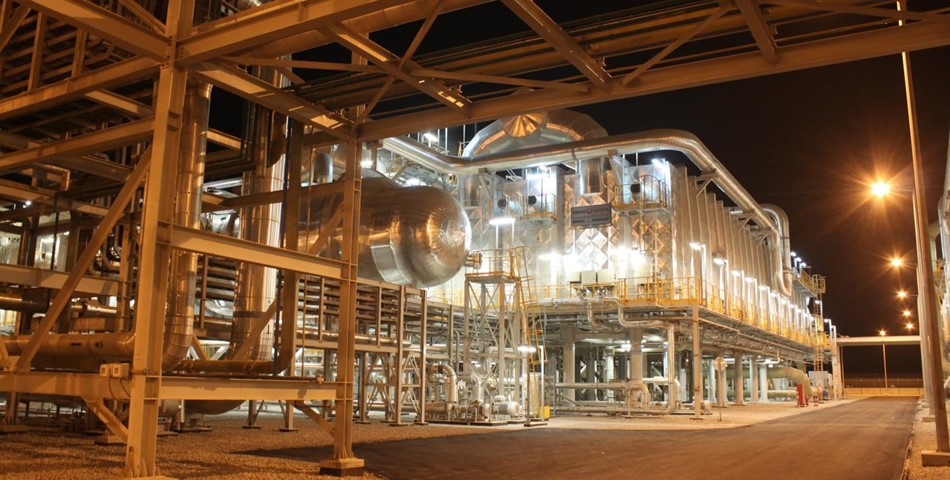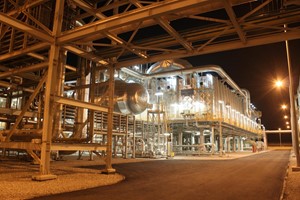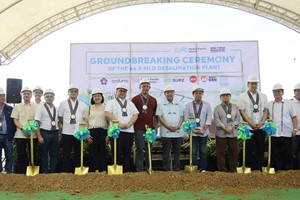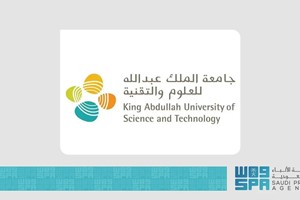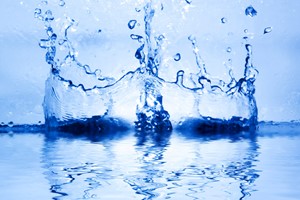The hybrid desalting concept is the combination of two or more processes in order to provide better environmental solutions and a lower water cost product than either alone can provide.
Early suggestions for hybrid desalination were based upon elimination of the requirement for a second pass to the RO process so that the higher-salinity RO product could be combined with the better-quality product from an MSF or MED plant. This is the simplest application of hybrid desalination. Since then, other concepts have been proposed for hybrid desalination.
Today, although RO can produce potable TDS in one pass, blending allows a simple solution where national standards require low levels of boron. The hybrid system received significant attention recently with implementation of desalination and power plants at Fujairah I and Fujairah II in UAE, Ras Al -Khair in Saudi Arabia, SWRO expansion plants in Fujairah I and Az-Zour South in Kuwait and current ongoing competition for hybrid of power and MSF-RO or MED-RO desalination for Az Zour North phase 2 in Kuwait.
While various hybrid concepts have been explored, this article focuses on the combination of distillation and membrane processes with power generation and the hybridization with renewable energy sources. Hybrid offers many additional advantages including the opportunity to better align demand for combined water and power production, reduce energy consumption, increased recovery and further minimize environmental impacts of power/desalination plants. With formation of Global Clean Water Desalination Alliance-"H20- CO2" hybrid combinations with renewable energy become focus of extensive research and development.
Hybrid Systems
Dual purpose power-desalination plants make use of thermal energy extracted or exhausted from power plants or generated by renewable source in the form of low pressure steam to provide heat input to thermal desalination plants for multistage flash (MSF) or multi-effect (MED) distillation processes. Today a lot of innovative solutions look at combining renewable energy: solar, geothermal, solar pond or ocean thermal energy conversion with desalination processes. The electrical energy can be also effectively used in electrically-driven desalination processes like Reverse Osmosis (RO) and Vapor Compression Distillation (VCD) processes.
The hybridization of nanofiltration as softening membrane process for feed of distillation plants MSF and MED could lead to significant improvement in productivity of desalination plants.
In general, the hybrid idea allows part of the distillation plant's heated coolant reject to be de-aerated, using low-pressure steam from the distillation plant to reduce corrosion and residual chlorine, and used as the feed to the SWRO plant. The higher temperature of the feed improves membrane performance (flux, at constant pressure, increases by 1.5-3 percent for each degree Celsius). This is particularly important during the winter, when seawater temperatures can drop to as low as 15 C. The MSF or MED plant's distillate, at less than 20 ppm TDS, is blended with the SWRO plant's product, making it possible to meet potable water standards for maximum TDS and chloride concentrations with higher SWRO plant product salinity.
This, in turn, means that the SWRO plants can be operated at higher conversion ratios, thereby reducing consumption of energy and chemicals and extending membrane useful life. The use of all or some of the preheated seawater cooling water discharge from a thermal desalination plant as feed to a SWRO plant enables elevating and controlling the SWRO plant's operating temperature at its optimal or any other higher desired value. As important eliminates need for built new intake and outfall structure as demonstrated by 30 MIGD Seawater RO expansions in Fujairah I and Kuwait Az-Zour South plants.
Feed water temperature affects the two main performance characteristics of a membrane: flux and salt rejection. Higher feed water temperatures increase not only flux but also salt passage. For all membranes, water production is a function of temperature, at constant feed pressure. Production will go up with temperature increasing by 1.5 percent to 3 percent per degree Celsius for nearly all membranes, thereby enabling reduction of the number of RO membrane modules required for a given permeate capacity. (This, of course, assumes that feed water quality is sufficiently good that the membrane fouling rate will not increase during operation at higher flux.) The increase of recovery rate at constant feed pressure at increased temperature in a RO hybrid system leads to reduction of specific power consumption.
Issue of concern is the compaction of membrane material (permeability decline) during long term operation at high feed pressure and elevated temperature; today maximum temperature for continuous operation for most of the membrane is 40 C, but clearly, we need membranes capable for continuous operation above 50 C. I am convinced that such membrane for seawater will be developed in view that in summer, in some places of the Gulf like in Dubai DEWA plants, the intake seawater exceeds 42 C.
In Nanofiltration systems, the increase in temperature of seawater feed results in higher rate of water permeability increase more than is expected in RO unit. In Nanofiltration membranes, the concentration polarization increase with temperature is lower than in RO membranes due to significantly higher salt transport through NF membranes and operating pressures of NF are significantly lower from 10-20 bars.
In hybrid systems, the use of Nanofiltration membranes operating at higher temperatures in combination with RO and MSF/MED provides additional opportunities to reduce desalination costs due to available heat from the power plant condenser or reject section of distillation plants. Specifically, by using feed comprising variable proportions of softened seawater and water containing a higher concentration of hardness ions than the softened stream, concentration of hardness is sufficiently reduced, thereby allowing a beneficial increase in the Top Brine Temperature (TBT) of the distillation desalination process. Higher operating temperatures provide an increase in productivity, recovery and performance at lower energy and chemical consumption. Thus, the cost of desalinated water production, including operation and maintenance, could be significantly reduced.
Hybrid plants have the potential to increase the average annual membrane permeate flow through increased flux rate and reduce the required membrane surface in the SWRO plants. The blending of SWRO and thermal plants' products makes it possible to use the low-salinity (less than 20 ppm TDS) distillation plant product to compensate for higher salinity SWRO plant product. However, if the plants are designed to operate at the high conversion ratios used today in most modern SWRO plants (45-50 percent), it is projected that product salinity will exceed 500 ppm TDS after about four years of operation, because of membrane performance degradation.
Recovery ratio (conversion) is one of the key RO design parameters. It determines the size of the feedwater handling system (e.g., intake, pretreatment, high pressure pumping) for a given plant size. Higher recoveries decrease the cost of the feedwater handling system and the required electrical and chemical consumption, while increasing the initial and replacement costs of the membrane system. The results imply that the energy consumption of RO can be reduced using a simple integration of MED+RO or MSF+RO hybrid arrangement in which the RO plant is fed the preheated seawater rejected from the heat rejection section of distillation plants.
Energy Conservation Using Hybrid Systems
In view of the dramatic concern with global climate conditions and a dramatic reduction in renewable generated power cost, hybrid (RO + distillation), hybrid (NF+distillation) or tri hybrid (NF+RO+distillation) systems offers significant savings in energy costs in comparison with the distillation-only option.
Hybrid System Using Multi-Effect Distillation
Multi-effect distillation (MED) is, in our opinion, the most important large-scale evaporative process offering significant potential for water cost reduction. Particularly MED and MED-NF has great potential with thermal renewable energy like thermal solar both concentrated or low temperature, geothermal, solar ponds or alternative nuclear energy. The major potential advantage of the MED process is the ability to operate at relatively low temperatures and produce a significantly higher Performance Ratio (PR) more than 15 pounds of the product per pound of steam, where MSF limits PR to 11. For the energy consumption in thermal plants, we have two parameters of efficiency. We need heat and electricity.
The first parameter is the amount of produced water per unit of steam, called gain-output ratio. That historically was about 8 pounds of water per pound of steam coming from the power plant. Today, we already have plants exceeding a ratio of 11. The second parameter in thermal desalination plants is electric power consumption, which for MED is about .9 to 1.5 kWhr/m3 per ton of water processed. As a matter of fact, in 2016 Veolia/Sidem inaugurated Az Zour North Phase 1 (AZN1) desalination plant IWPP - 1550 MW +107 MIGD an EPC contract built in Kuwait with a daily production capacity of 486,400 cubic meters of water. The plant is MED-TVC with 10 x 10.84 MIGD units in total 107 MIGD. But most important is the ability to lower the process power consumption to 0.9 kWh/m3 with GOR 11; meaning that 1 ton of steam generates 11 ton of desalinated water. Hyundai will be responsible for building the 1,500-MW power station. The key here is that the energy for the desalination plant is provided by backpressure steam from combine cycle power plant typically at 2.7 bars. The lower the pressure of the steam we can use for the desalination and the higher GOR the less power loss is experienced in the power cycle. This loss is assigned to energy consumption of desalination.
The future calls for increasing the top operating temperature, finding new ways to improve heat transfer performance to reduce the heat exchange area, searching for an increase in heat transfer performance by tube enhancement, and using a very thin wall in tubular materials. The critical challenge is to adopt Nanofiltration as means to dramatically increase output and increase the efficiency of MED plants.
Hybrid Using Nanofiltration - Membrane Softening
Novel Thermal Hybrid systems in combination with clean renewable and nuclear energy. Nanofiltration Softening Membranes with Multi-Effect Distillation solutions, which will be able to operate with low temperature sources of thermal energy, like high efficiency solar water heating panels, solar pond both with pure water or salinity gradient and using low temperature geothermal resource as well as coupled with more conventional lower temperature concentrated solar Parabolic Trough Collectors or Low-cost, high-efficiency non-tracking trough CSP receiver, or geothermal energy, to produce relatively low temperature heat source needed for desalination.
Membrane softening technology adapted to hybrid with distillation processes could lead to a significant increase in the productivity of existing and future distillation plants as well as resulting in better process economics. As a result, the selectivity of NF membranes for monovalent and bivalent anions is significantly different as compared to regular RO membranes. Specially designed NF membranes have the capability of high rejection for divalent ions (Ca, Mg and SO4), while allowing relatively high passage of monovalent ions (Cl, Na and K). The nanofiltration membrane performed significantly better than the design specifications. Sulphates rejection exceeded always 95 percent rejection, calcium hardness was reduced by over 55 percent, magnesium hardness by over 80 percent. These results were achieved at feed temperature controlled at 35 C.
Pioneering work on Nanofiltration membrane NF softening technology as applied to desalination processes and specifically to seawater desalination was develop by two groups: Leading Edge Technologies Ltd (LET) and the Saline Water Conversion Corporation (SWCC) of Saudi Arabia. The great potential of Nanofiltration membrane softening technology was brought to focus by an award by Sharjah Electricity and Water Authority (SEWA) to LET and Besix Consortium for the first commercial LET Nanofiltration System to increase the capacity of an existing MSF plant from nominal 22,7000 m3/day to 32,800 m3/day (5 MIGD to 7.2 MIGD). This 40 percent+ increase in capacity of MSF unit was a result of a two-year demonstration and simulation program developed jointly with SEWA. The additional capacity is achieved without building a new intake structure or new power plant in a very limited space that would not allow construction of a new desalination plant. The system involves construction of a NF plant to provide partial membrane softening of feed to MSF as well as modifications to existing MSF plant to be capable to achieve the increased capacity. NF membrane softening technology could significantly improve operation and reduce the cost of the MED process, by eliminating the risk of scaling and fouling. NF technology will permit an increase in the top temperature resulting in a significant increase in output and the performance ratio.



